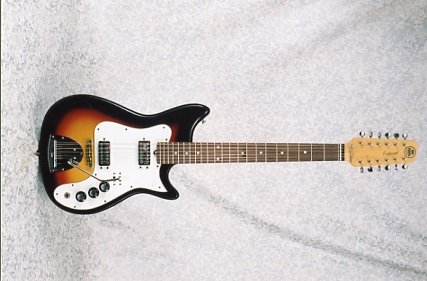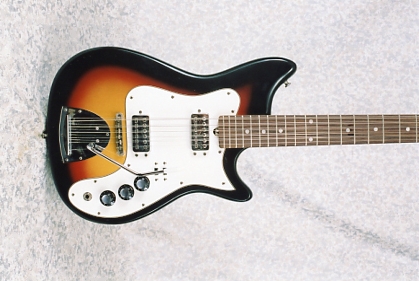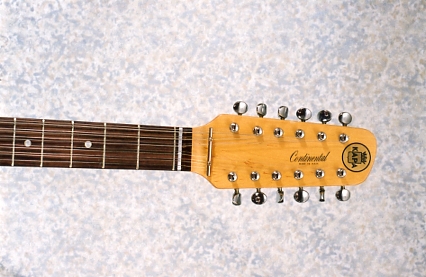
A View From the Back of the Rack
From the Temple of Doom (I): Koob, Albert, Patricia, and Adeline
By Michael Wright
The Different Strummer
Imagine someone telling you about an old-time music store that had a huge stash of unsold guitars from the 1960s, plus some guitar effects from the ‘70s lying around in its upper floors in Newark, NJ. Well, you can bet it didn’t take long for me to beat a path to the door of Newark Music City (calm down; this was a long time ago and, while the company still exists, it’s long gone from Newark). Even though I was late in the game, there were still unmined treasures to be had. A real Temple of Doom!
I pulled a lot of good stuff out of Music City and owner John Ciarfella was great to work with. The store was full of New-Old-Stock gear, not to mention a bunch of vintage pieces taken in on trade over the years and just never sold. Maestro pedal effects, replacement Victrola parts, Japanese guitar hardware. Plus this NOS c. 1966 Kapa Continental No. CO-XII-V 12-String, culled from a huge pile in their old cardboard boxes stacked in a corner on the 3rd Floor. All leftover from when John’s father ran Newark Musical Merchandise and distributed Kapas, but was never able to sell. More about the Kapa later.

But the trip to the trip was the upper floors. Music City was actually two joined 4-story buildings on a corner near the “new” Newark performance center. The stairs were rickety and the floors unfinished, everything dusty. The 2nd floor was full of old shelving and drawers filled with the NOS stuff. The stairs between the floors and buildings were a maze.
After I’d bought a number of things on several trips, John took me up to the 4th floor of the corner building. That had originally been a speakeasy and on the 4th floor was a Burlesque theater. It was still there. The proscenium stage, all the seats, tattered curtains. Water damage and some graffiti by locals who’d broken in through the skylight. It was awesome, almost dwarfing the Kapa find.
But, unlike the KAPA, I couldn’t take the theater home with me. Kapa was a brand started by another music distributorship begun in 1960 and owned by a Dutch immigrant named Koob Veneman in Rockville, BD. Veneman’s father had operated a music store in Holland and distributed guitars carrying the AMKA brand, an acronym made up of the first letters of his childrens’ names (K was Koob). In 1962 Veneman decided to plunge into the Guitar Boom and manufacture his own line of solid- and hollowbody electric guitars and basses in nearby Hyattsville, MD. He named the guitars KAPA after his family, himself, son Albert, daughter Patricia, and wife Adeline.
KAPA began in 1963 or ‘64 (sources differ) with three solidbodies, the Challenger (sort of a two-pickup mini-Strat), the Wildcat (three-pickup version), and an occasional single-pickup Cobra, made from scraps. KAPAs were famous for their ultra-thin necks, made by KAPA, not Höfner as some online sources claim. Until 1966 the pickups, which looked like Höfners, were made by KAPA.
In 1966 KAPA’s lumber stock got thinner and they began using Pix pickups made in Germany, the same as used by Höfner (but not made by Höfner). They also switched from threeway toggles to sliding on/off switches about this time. KAPA also introduced the Jazzmaster-style Continental in ‘66, including the 12-string example seen here.
KAPA guitars were actually quite well made, very easy to play, and give off a nice vintage ‘60s vibe. They made upwards of 120,000 of them, so they’re not especially rare, but then, not too many people ever thought they’d be of interest to anyone in the future!
Unfortunately, KAPA doesn’t seem to have been very concerned about consistency, and you’ll find Continentals with Challenger decals and vice versa, and dating is primarily a matter of guesswork. In 1968 KAPA added a Minstrel teardrop-shaped solid to the line and in 1969 some thinline hollowbodies with bodies made in Japan. However, by then sales were in decline and in 1970 Veneman shut KAPA down, selling leftover supplies and machinery to Micro-Frets and Mosrite. Veneman sold Bradley copy guitars during the 1970s. In the 1980s the shop got into the mailorder music biz. The shop still exists, but as a premier Guitar Center location.
In any case, besides being a relatively rare ‘60s soldibody 12-string, this KAPA Continental carries the cachet of having been found unsold in a musty old corner of a musical Temple of Doom in Newark, NJ, next door and an obscure staircase away from a mothballed attic burlesque theater!
Michael Wright, The Different Strummer, is a collector and historian whose work is featured in Vintage Guitar Magazine.



I remember purchasing my first (of many) electric 12-string from Fat Dog, of Subway Guitars, in Berkeley: it was a Kapa Continental, in candy-apple red. It worked well enough, and the point about the thin necks is true – they’re very thin. That probably means you’re going to need to adjust the truss rod and perform a setup if you come upon one. As I recall, the thin stamped-metal bridge gave the guitar a sort of Danelectro-like vibe. Interesting pickups on those!
Thanks for a blast from the past.
wow. I live in NJ and always wanted to go there. but, pretty scary neighborhood back in the day! oddly, there were some other similar stores in northern NJ, and they all seemed to have a stash of Kapas… I still kick myself for not buying one.
Interesting about Veneman’s – always thought Kapas were made overseas. Used to go to the Venemans store in MD when I lived in DC – great store!
thanks for this!
My first guitar was a Kapa Cobra purchased second hand in 1965 from The Guitar Shop in DC for $60. I replaced it with an abused 1962 Jazzmaster in 67, that I sold a year later for $90, (ouch), and purchased my first new guitar from Koob at his Bethesda, MD store, two years later, (a 68 SG Standard). Off to college in 70 where my SG and Twin Reverb were stolen from my apartment.
Back to DC from college in 75 with an architecture degree, and coincidentally became the local architect for Veneman music, designing their corporate headquarters office building and warehouse in Gaithersburg, MD.
Koob was a great guy to work with, warm and welcoming, and a true enthusiast!
Unbelievably, I found my original Kapa Cobra on eBay about 6 months ago, and it is again in my possession, (apparently it never really left the DC area).
Bought me an electric Gibson SG years ago to play with a band. Got it at a pawn store for $300.00. A couple of months later I came home to that guitar and 2 others stolen from me. Anyway when I got the insurance money for it they gave me $900.00 reimbursement! I was amazed. Didn’t know it was worth that much! Miss the guitar though.
I was amazed to find there was as site regarding KAPA guitars because I worked at the factory in 1965 to 1967. I worked as an assembler on the finished product line putting together the various parts of the guitar from the body to the neck to the electronics. As far as I can remember, almost all of the materials that we used were created and crafted in the factory from the raw wood to the finished bodies to the paint shop to the electronics assembly to all of the products in the neck, the frets – everything was all handmade there.
I always enjoyed walking around the factory when I wasn’t too busy on the assembly line to watch the various stations making the parts for the guitars. It was a very busy factory. We never had any real down time, we were constantly working, producing the guitars as fast as we could. I remember Mr. Veneman because he interviewed and hired me and always treated the employees like they were part of the extended family. I remember him bringing his two children to the factory and him showing them around and introducing them to the employees. Everyone who worked at the factory was quite capable of the position that Mr. Veneman had given them in the guitar-making process of producing a quality guitar. I especially remember the one and only painter who did such a spectacular job of bringing the raw wood to its finished beautiful state. I remember on occasion when my drill would slip while installing the face plate putting a dent into the beautiful paint job which I would then have to return to the painter to have him touch it up. He never got mad at me, just gave me a great big grin and laughed. But I secretly think that he quite often thought I did it on purpose so I could come back and watch him laugh. He was happy all the time. I asked him why he was happy all the time and he said, “Man, I just love painting these guitars.” And he was good at it.
I’ve always had fond memories of working at KAPA guitar, and I’m wondering if any of the other employees from the factory during that time period are still around. I’d love to hear from you. Jerry sromer118@verizon.net
Nice website!
Nice post
I took lessons at the store I Silver Spring back in ’64 &’65. I loved those KAPA’s. But my dad was all about my big old Harmony. Now 50+ years later I own 4 KAPA’s, and I play them through an Ampeg geminay II and a Silvertone Twin 12. They sound great.